Oceanic Impact on European Climate Changes during the Quaternary
Abstract
1. Introduction
1.1. Quaternary and Climate
1.2. Climate Regime in the North Atlantic Region
2. Causes of Major Climate Changes in the European Atlantic Margin Associated with Deglaciations
2.1. North Atlantic Circulation and SST Oscillations
2.2. Migration of the Arctic Front
2.3. Weakening of the Atlantic Meridional Overturning Circulation
3. Climate Variations in Inland Europe
3.1. Influence of NAO-Index Variations in the European Climate
3.2. Influence of Sea Surface Temperature in the European Climate Variations
3.3. Influence of the Thermohaline Circulation
3.4. Influence of the Ice Sheet Extension and Volume
4. Conclusions
Funding
Acknowledgments
Conflicts of Interest
References
- Mercer, J. Simultaneous climatic change in both Hemispheres and similar bipolar interglacial warming: Evidence and implications. In Climate Processes and Climate Sensitivity, Geophysical Monograph 29; Ewing, M., Ed.; American Geophysical Union: Washington, DC, USA, 1984; pp. 307–313. [Google Scholar]
- Berger, A.; Li, X.S.; Loutre, M.F. Modelling northern hemisphere ice volume over the last 3 Ma. Quat. Sci. Rev. 1999, 18, 1–11. [Google Scholar] [CrossRef]
- Lisiecki, L.E.; Raymo, M.E. Plio-Pleostocene climate evolution: Trends and transitions in glacial cycle dynamics. Quat. Sci. Rev. 2007, 26, 56–69. [Google Scholar] [CrossRef]
- Lang, N.; Wolff, E.W. Interglacial and glacial variability from the last 800 ka in marine, ice and terrestrial archives. Clim. Past 2011, 7, 361–380. [Google Scholar] [CrossRef]
- Raynaud, D.; Loutre, M.F.; Ritz, C.; Chappellaz, J.; Barnola, J.M.; Jouzel, J.; Lipenkov, V.Y.; Petit, J.R.; Vimeux, F. Marine Isotope Stage (MIS) 11 in the Vostok ice core: CO2 forcing and stability of East Antarctica. Geophys. Monog. 2003, 137, 27–40. [Google Scholar]
- Milankovitch, M. Canon of insolation and the ice-age problem. Roy. Serb. Sci. Spec. Publ. Sect. Math. Nat. Sci. 1941, 33, 633. [Google Scholar]
- Imbrie, J.; Boyle, E.A.; Clemens, S.C.; Duffy, A.; Howard, W.R.; Kukla, G.; Kutzbach, J.; Martinson, D.G.; McIntyre, A.; Mix, A.C.; et al. On the Structure and Origin of Major Glaciation Cycles 1. Linear responses to Milankovitch forcing. Paleoceanography 1992, 7, 701–738. [Google Scholar] [CrossRef]
- Ruddiman, W.F. Ice-driven CO2 feedback on ice volume. Clim. Past 2006, 2, 43–55. [Google Scholar] [CrossRef]
- Huybers, P. Glacial variability over the last two million years: An extended depth-derived agemodel, continuous obliquity pacing and the Pleistocene progression. Quat. Sci. Rev. 2007, 26, 37–55. [Google Scholar] [CrossRef]
- Lisiecki, L.E.; Raymo, M.E. A Pliocene-Pleistocene stack of 57 globally distributed benthic d18O records. Paleoceanography 2005, 20, PA1003. [Google Scholar]
- Laskar, J.; Robutel, P.; Joutel, F.; Gastineau, M.; Correia, A.C.M.; Levrard, B. A long- term numerical solution for the insolation quantities of the Earth. Astron. Astrophys. 2004, 428, 1. [Google Scholar] [CrossRef]
- Shackleton, N.J.; Pisias, N.G. Atmospheric carbon dioxide, orbital forcing and climate. In The Carbon Cycle and Atmospheric CO2: Natural Variations, Archean to Present; Sundquist, E.T., Broecker, W.S., Eds.; American Geophysical Union: Washington, DC, USA, 1985. [Google Scholar]
- Kennett, J.P.; Cannariato, K.G.; Hendy, I.L.; Behl, R.J. Carbon isotopic evidence for methane hydrate instablity during Quaternary interstadials. Science 2000, 288, 128–133. [Google Scholar] [CrossRef] [PubMed]
- Ruddiman, W.F. Orbital insolation, ice volume and greenhouse gases. Quat. Sci. Rev. 2003, 22, 1597–1629. [Google Scholar] [CrossRef]
- Toggweiler, J.R.; Russell, J.L.; Carson, S.R. Midlatitude westerlies, atmospheric CO2 and climate change during the ice ages. Paleoceanography 2006, 21. [Google Scholar] [CrossRef]
- Broecker, W.S.; Kennett, J.P.; Flower, B.P.; Teller, J.T.; Trumbore, S.; Bonani, G.; Wolfli, W. Routing of meltwater from the Laurentide Ice Sheet during the Younger Dryas cold episode. Nature 1989, 341, 318–321. [Google Scholar] [CrossRef]
- Raymo, M.E.; Oppo, D.W.; Curry, W.V. The mid-Pleistocene climate transition: A deep sea carbon isotopic perspective. Paleoceanography 1997, 12, 546–559. [Google Scholar] [CrossRef]
- McManus, J.F.; Francois, R.; Gherardi, J.; Keigwin, L.; Brown-Leger, S. Collapse and rapid resumption of Atlantic meridional circulation linked to deglacial climate change. Nature 2004, 428, 834–837. [Google Scholar] [CrossRef] [PubMed]
- Pisias, N.G.; Clark, P.U.; Brook, E.J. Modes of global climate variability during Marine Isotope Stage 3 (60–26 ka). J. Clim. 2010, 23, 1581–1588. [Google Scholar] [CrossRef]
- Imbrie, J.; Berger, A.; Boyle, E.A.; Clemens, S.C.; Duffy, A.; Howard, W.R.; Kukla, G.; Kutzbach, J.; Martinson, D.G.; McIntyre, A.; et al. On the structure and origin of major glaciation cycles: 2. The 100,000-year cycle. Paleoceanography 1993, 8, 699–735. [Google Scholar] [CrossRef]
- Denton, G.H.; Anderson, R.F.; Toggweiler, J.R.; Edwards, R.L.; Schaefer, J.M.; Putnam, A.E. The Last Glacial Termination. Science 2010, 328, 1652–1656. [Google Scholar] [CrossRef]
- Heinrich, H. Origin and consequences of cyclic ice rafting in the Northeast Atlantic Ocean during the past 130,000 yrs. Quat. Res. 1988, 29, 142–152. [Google Scholar] [CrossRef]
- Broecker, W.S. Massive iceberg discharges as triggers for global climate change. Nature 1994, 372, 421–424. [Google Scholar] [CrossRef]
- Cortijo, E.; Yiou, P.; Labeyrie, L.; Cremer, M. Sedimentary record of rapid climatic variability in the North Atlantic Ocean during the last glacial cycle. Paleoceanography 1995, 10, 911–926. [Google Scholar] [CrossRef]
- Hodell, D.A.; Channell, J.E.T.; Curtis, J.H.; Romero, O.E.; Röhl, U. Onset of “Hudson Strait” Heinrich events in the eastern North Atlantic at the end of the middle Pleistocene transition (~640 ka)? Paleoceanography 2008, 23. [Google Scholar] [CrossRef]
- Channell, J.E.T.; Hodell, D.A.; Romero, O.; Hillaire-Marcel, C.; de Vernal, A.; Stoner, J.S.; Mazaud, A. Roehl. IODP Site U1302-U1303 (Orphan Knoll): Correlation of Brunhes detrital-layer stratigraphy into the North Atlantic. Earth Planet. Sci. Letts. 2012, 317–318, 218–230. [Google Scholar] [CrossRef]
- Broecker, W.S.; Bond, G.; Klas, M.; Clark, E.; McManus, J. Origin of the nothern Atlantic’s Heinrich events. Clim. Dyn. 1992, 6, 265–273. [Google Scholar] [CrossRef]
- Bond, G.C.; Lotti, R. Iceberg discharges into the North Atlantic on millennial time scales during the last glaciation. Science 1995, 267, 1005–1010. [Google Scholar] [CrossRef] [PubMed]
- Stuiver, M.; Grootes, P.M. GISP2 oxygen isotope ratios. Quat. Res. 2000, 53, 277–284. [Google Scholar] [CrossRef]
- Huber, C.; Leuenberger, M.; Spahni, R.; Flückiger, J.; Schwander, J.; Stocker, T.F.; Johnsen, S.; Landais, A.; Jouzel, J. Isotope calibrated Greenland temperature record over marine isotope stage 3 and its relation to CH4. Earth Planet. Sci. Lett. 2006, 243, 504–519. [Google Scholar] [CrossRef]
- Dansgaard, W.; Johnsen, S.J.; Clausen, H.B.; Dahl-Jensen, D.; Gundestrup, N.S.; Hammer, C.U.; Hvidberg, C.S.; Steffensen, J.P.; Sveinbjörnsdottir, A.E.; Jouzel, J.; et al. Evidence for general instability of past climate from a 250 kyr ice-core record. Nature 1993, 364, 218–220. [Google Scholar] [CrossRef]
- Grootes, P.M.; Stuiver, M.; White, J.W.C.; Johnsen, S.; Jouzel, J. Comparison of oxigen isotope records from the GISP2 and GRIP Greenland ice cores. Nature 1993, 255, 522–554. [Google Scholar]
- Broecker, W.S.; Bond, G.; Millie, K.; Geotges, B.; Willy, W. A salt oscillator in the glacial Atlantic? 1, The concept. Paleoceanography 1990, 5, 469–477. [Google Scholar] [CrossRef]
- Broecker, W.S.; Peteet, D.M.; Rind, D. Does the ocean-atmosphere system have more than one stable mode of operation? Nature 1985, 315, 21–26. [Google Scholar] [CrossRef]
- Bond, G.; Heinrich, H.; Broecker, W.; Labeyrie, L.; McManus, J.; Andrews, J.; Huon, S.; Jantschik, R.; Clasen, S.; Simet, C.; et al. Evidence for massive discharges of icebergs into the North Atlantic Ocean during the last glacial period. Nature 1992, 360, 245–249. [Google Scholar] [CrossRef]
- Wright, A.K.; Flower, B.P. Surface and deep ocean circulation in the subpolar North Atlantic during the mid-Pleistocene revolution. Paleoceanography 2002, 17, 1068. [Google Scholar] [CrossRef]
- Barker, S.; Knorr, G.; Edwards, L.; Parrenin, F.; Putnam, A.E.; Skinner, L.C.; Wolff, E.; Ziegler, M. 800,000 years of abrupt climate variability. Science 2011, 334, 347. [Google Scholar] [CrossRef] [PubMed]
- Bjerknes, J. Atlantic air-sea interaction. Adv. Geophys. 1964, 10, 1–82. [Google Scholar]
- Maze, J.P.; Arhan, M.; Mercier, H. Volume budget of the eastern boundary layer off the Iberian Peninsula. Deep Sea Res. Part I Oceanog. Res. Pap. 1997, 44, 1543–1574. [Google Scholar] [CrossRef]
- Coelho, H.; Neves, T.; White, M.; Leitpo, P.; Santos, A. A model for ocean circulation on the Iberian coast. J. Mar. Syst. 2002, 32, 181–198. [Google Scholar] [CrossRef]
- Hurrell, J.W. Decadal trends in the North Atlantic Oscillation: Regional temperatures and precipitation. Science 1995, 269, 676–679. [Google Scholar] [CrossRef] [PubMed]
- Dickson, R.; Lazier, J.; Meinke, J.; Thines, P.; Swift, J. Long term coordinated changes in the convective activity of the North Atlantic. Progr. Oceanogr. 1996, 38, 241–295. [Google Scholar] [CrossRef]
- Deser, C.; Walsh, J.E.; Timlin, M.S. Arctic sea ice variability on the context of recent atmospheric circulation trends. J. Clim. 2000, 13, 617–633. [Google Scholar] [CrossRef]
- Schieller, A.; Milkolajewicz, U.; Voss, R. The stability of North Atlantic thermohaline circulation in a coupled ocean-atmosphere general circulation model. Clim. Dyn. 1997, 13, 325–347. [Google Scholar] [CrossRef]
- Black, D.E.; Peterson, L.C.; Overpeck, J.T.; Kaplan, A.; Evans, M.N.; Kashgarian, M. Eight centuries of North Atlantic Ocean variability. Science 1999, 286, 1709–1713. [Google Scholar] [CrossRef] [PubMed]
- Peterson, L.C.; Haug, G.H.; Hughen, K.A.; Tohl, U. Rapid changes in the tropical hydrologic cycle of the tropical Atlantic during the last glacial. Science 2000, 290, 1947–1951. [Google Scholar] [CrossRef] [PubMed]
- Schmidt, M.W.; Spero, H.J.; Lea, D.W. Links between salinity variation in the Caribbean and North Atlantic thermohaline circulation. Nature 2004, 428, 160–163. [Google Scholar] [CrossRef] [PubMed]
- Rodo, W.; Baert, E.; Comin, F.A. Variations in seasonal rainfall in southern Europe during the present century: Relationships with the North Atlantic Oscillation and the El Niño-Southern Oscillation. Clim. Dyn. 1997, 13, 275–284. [Google Scholar] [CrossRef]
- Trigo, R.M.; Osborn, T.J.; Corte-Real, J.M. The North Atlantic Oscillation influence on Europe: Climate impacts and associated physical mechanisms. Clim. Res. 2002, 20, 9–17. [Google Scholar] [CrossRef]
- McCartney, M.S.; Talley, L.D. The Subpolar Mode Water of the North Atlantic Ocean. J. Phys. Oceanogr. 1982, 12, 1169–1188. [Google Scholar] [CrossRef]
- Brambilla, E.; Talley, L.D. Subpolar Mode Water in the northeastern Atlantic: 1. Averaged properties and mean circulation. J. Geophys. Res. 2008, 113, C04025. [Google Scholar] [CrossRef]
- Rios, A.F.; Perez, F.F.; Fraga, F. Water Masses in the Upper and Middle North-Atlantic Ocean East of the Azores. Deep Sea Res. Part A 1992, 39, 645–658. [Google Scholar] [CrossRef]
- Peliz, A.; Dubert, J.; Santos, A.M.P.; Oliveira, P.B.; Le Cann, B. Winter upper ocean circulation in the Western Iberian Basin—Fronts, eddies and poleward flows: An overview. Deep Sea Res. Part I 2005, 52, 621–646. [Google Scholar] [CrossRef]
- Fiúza, A.F.G.; Hamann, M.; Ambar, I.; Díaz del Río, G.; González, N.; Cabanas, J.M. Water masses and their circulation off western Iberia during May 1993. Deep Sea Res. Part I 1998, 45, 1127–1160. [Google Scholar] [CrossRef]
- Pflaumann, U.; Sarnthein, M.; Chapman, M.; de Abreu, L.; Funnell, B.; Huels, M.; Kiefer, T.; Maslin, M. Glacial North Atlantic: Sea-surface conditions reconstructed by GLAMAP 2000. Paleoceanography 2003, 18, 1065. [Google Scholar] [CrossRef]
- Martrat, B.; Grimalt, J.O.; Shackleton, N.J.; de Abreu, L.; Hutterli, M.A.; Stocker, T.F. Four Climate Cycles of Recurring Deep and Surface Water Destabilizations on the Iberian Margin. Science 2007, 317, 502–507. [Google Scholar] [CrossRef] [PubMed]
- Rodrigues, T.; Voelker, A.H.L.; Grimalt, J.O.; Abrantes, F.; Naughton, F. Iberian Margin sea surface temperature during MIS15 to 9 (580–300 ka): Glacial suborbital variability versus interglacial stability. Paleoceanography 2011, 26, 1–16. [Google Scholar] [CrossRef]
- Martin-Garcia, G.M. The Influence of Deglaciations in the Mid-Latitude European Climate. In Deglaciation: Processes, Causes and Consequences; Boone, M., Ed.; Nova Science Publishers: New York, NY, USA, 2017; pp. 107–140. ISBN 978-1-53612-501-6. [Google Scholar]
- Martin-Garcia, G.M. Environmental Variations in the North Atlantic in Response to Quaternary Glaciations; Nova Science Publishers: New York, NY, USA, 2018; p. 139. ISBN 978-1-53613-367-7. [Google Scholar]
- Martin-Garcia, G.M.; Alonso-Garcia, M.; Sierro, F.J.; Hodell, D.A.; Flores, J.A. Severe cooling episodes at the onset of deglaciations on the Southwestern Iberian margin from MIS 21 to 13 (IODP site U1385). Glob. Planet. Chang. 2015, 135, 159–169. [Google Scholar] [CrossRef]
- Locarnini, R.A.; Mishonov, A.V.; Antonov, J.I.; Boyer, T.P.; Garcia, H.E.; Baranova, O.K.; Zweng, M.M.; Johnson, D.R. World Ocean Atlas 2009, Volume 1: Temperature; NOAA Atlas NESDIS 68; Levitus, S., Ed.; Government Printing Office: Washington, DC, USA, 2010; p. 184.
- Martin-Garcia, G.M.; Sierro, F.J.; Hodell, D.A.; Flores, J.A. Climate oscillations on the SW Iberian Margin from 860 to 490 ka. In Proceedings of the VIII Conference MIA 2015, Málaga, Spain, 21–23 September 2015; pp. 429–432. [Google Scholar]
- Kucera, M.; Weinelt, M.; Kiefer, T.; Pflaumann, U.; Hayes, A.; Weinelt, M.; Chen, M.; Mix, A.C.; Barrows, T.T.; Cortijo, E.; et al. Reconstruction of sea-surface temperatures from assemblages of planktonic foraminifera: Multi-technique approach based on geographically constrained calibration data sets and its application to glacial Atlantic and Pacific Oceans. Quat. Sci. Rev. 2005, 24, 951–998. [Google Scholar] [CrossRef]
- Calvo, E.; Villanueva, J.; Grimalt, J.O.; Boelaert, A.; Labeyrie, L. New insights into the glacial latitudinal temperature gradients in the North Atlantic. Results from Uk’37 sea surface temperatures and terrigenous inputs. Earth Planet. Sci. Lett. 2001, 188, 509–519. [Google Scholar] [CrossRef]
- Naafs, B.D.A.; Stein, R.; Hefter, J.; Khélifi, N.; De Schepper, S.; Haug, G.H. Late Pliocene changes in the North Atlantic Current. Earth Planet. Sci. Lett. 2010, 298, 434–442. [Google Scholar] [CrossRef]
- Voelker, A.H.L.; Rodrigues, T.; Billups, K.; Oppo, D.; McManus, J.; Stein, R.; Hefter, J.; Grimalt, J.O. Variations in mid-latitude North Atlantic surface water properties during the mid-Brunhes (MIS 9-14) and their implications for the thermohaline circulation. Clim. Past 2010, 6, 531–552. [Google Scholar] [CrossRef]
- Eynaud, F.; De Abreu, L.; Voelker, A.; Schönfeld, J.; Salgueiro, E.; Turon, J.L.; Penaud, A.; Toucanne, S.; Naughton, F.; Goñi, M.F.; et al. Position of the Polar Front along the western Iberian Margin during key cold episodes of the last 45 ka. Geochem. Geophys. Geosyst. 2009, 10, Q07U05. [Google Scholar] [CrossRef]
- Bard, E.; Rostek, F.; Turon, J.L.; Gendreau, S. Hydrological impact of Heinrich Events in the Subtropical Northeast Atlantic. Science 2000, 289, 1321–1324. [Google Scholar] [CrossRef] [PubMed]
- Lebreiro, S.M.; Moreno, J.C.; McCave, I.N.; Weaver, P.P.E. Evidence for Heinrich layers off Portugal (Tore Seamount: 39° N, 12° W). Mar. Geol. 1996, 131, 47–56. [Google Scholar] [CrossRef]
- Lebreiro, S.M.; Moreno, F.C.; Abrantes, F.; Pflaumann, U. Productivity and paleoceanographic implications on the Tore Seamount (Iberian Margin) during the last 225 kyr: Foraminiferal evidence. Paleoceanography 1997, 12, 718–727. [Google Scholar] [CrossRef]
- Zahn, R.; Schönfeld, J.; Kudrass, H.R.; Park, M.H.; Erlenkeuser, H.; Grootes, P. Thermohaline instability in the North Atlantic during meltwater events: Stable isotope and ice-rafted detritus records from core SO75-26KL, Portuguese margin. Paleoceanography 1997, 12, 696–710. [Google Scholar] [CrossRef]
- Cayre, O.; Lancelot, Y.; Vincent, E. Paleoceaanographic reconstructions from planktonic foraminifera ogg the Iberian Margin: Temperature, salinity and Heinrich events. Paleoceanography 1999, 14, 384–396. [Google Scholar] [CrossRef]
- de Abreu, L.; Abrantes, F.; Shackleton, N.J.; Tzedakis, P.C.; McManus, J.F.; Oppo, D.W.; Hall, M.A. Ocean climate variability in the eastern North Atlantic during interglacial marine isotope stage 11: A partial analogue to the Holocene? Paleoceanography 2005, 20. [Google Scholar] [CrossRef]
- Vautravers, M.J.; Shackleton, N.J. Centennial-scale surface hydrology off Portugal during marine isotope stage 3: Insights from planktonic foraminiferal fauna variability. Paleoceanography 2006, 21, PA3004. [Google Scholar] [CrossRef]
- de Abreu, L.; Shackleton, N.J.; Schönfeld, J.; Hall, M.A.; Chapman, M. Millennial-scale oceanic climate variability off the western Iberian margin during the last two glacial periods. Mar. Geol. 2003, 196, 1–20. [Google Scholar] [CrossRef]
- Martin-Garcia, G.M.; Sierro, F.J.; Flores, J.A.; Abrantes, F. Change in the North Atlantic circulation associated with the mid-Pleistocene transition. Clim. Past 2018, 14, 1639–1651. [Google Scholar] [CrossRef]
- Martin-Garcia, G.M.; Sierro, F.J.; Flores, J.A. Reconstruction of North Atlantic circulation affecting the SW Iberian Margin during Glacial stages from 840 to 530 ka. In Proceedings of the VIII Conference MIA 2015, Málaga, Spain, 21–23 September 2015; pp. 237–240. [Google Scholar]
- Alonso-Garcia, M.; Sierro, F.J.; Flores, J.A. Arctic front shifts in the subpolar north Atlantic during the Mid-Pleistocene (800–400 ka) and their implications for ocean circulation. PA3 2011, 311, 268–280. [Google Scholar] [CrossRef]
- Hodell, D.; Lourens, L.; Crowhurst, S.; Konijnendijk, T.; Tjallingii, R.; Jiménez-Espejo, F.; Skinner, L.; Tzedakis, P.C.; Members, T.S.; Abrantes, F.; et al. A reference time scale for Site U1385 (Shackleton Site) on the SW Iberian Margin. Glob. Planet. Chang. 2015, 133, 49–64. [Google Scholar] [CrossRef]
- Ruddiman, W.F.; Raymo, M.E.; Martinson, D.G.; Clement, B.M.; Backman, J. Sea surface temperature reconstruction of DSDP Site 94-607 in the North Atlantic. Paleoceanography 1989, 4, 353–412. [Google Scholar] [CrossRef]
- Sabine, C.L.; Feely, R.A.; Gruber, N.; Key, R.M.; Lee, K.; Bullister, J.L.; Wanninkhof, R.; Wong, C.S.; Wallace, D.W.R.; Tilbrook, B.; et al. The oceanic sink for anthropogenic CO2. Science 2004, 305, 367–371. [Google Scholar] [CrossRef] [PubMed]
- Adkins, J. The role of deep ocean circulation in setting glacial climates. Paleoceanography 2013, 28, 539–561. [Google Scholar] [CrossRef]
- Stocker, T.F. Past and future reorganisations in the climate system. Quat. Sci. Rev. 1999, 19, 301–319. [Google Scholar] [CrossRef]
- Böhm, E.; Lippold, J.; Gutjahr, M.; Frank, M.; Blaser, P.; Antz, B.; Fohlmeister, J.; Frank, N.; Andersen, M.B.; Deininger, M. Strong and deep Atlantic meridional overturning circulation during the last glacial cycle. Nature 2014, 517, 73. [Google Scholar] [CrossRef]
- Boyle, E.; Keigwin, L. North Atlantic thermohaline circulation during the past 20,000 years linked to high-latitude surface temperature. Nature 1987, 330, 35–40. [Google Scholar] [CrossRef]
- Sarnthein, M.; Winn, K.; Jung, S.J.A.; Duplessy, J.C.; Labeyrie, L.; Erlenkeuser, H.; Ganssen, G. Changes in east Atlantic deepwater circulation over the last 30,000 years: Eight time slice reconstructions. Paleoceanography 1994, 9, 209–267. [Google Scholar] [CrossRef]
- Lippold, J.; Gutjahr, M.; Blaser, P.; Christner, E.; de Carvalho Ferreira, M.L.; Mulitza, S.; Christl, M.; Wombacher, F.; Böhm, E.; Antz, B.; et al. Deep water provenance and dynamics of the (de)glacial Atlantic meridional overturning circulation. Earth Planet. Sci. Lett. 2016, 445, 68–78. [Google Scholar] [CrossRef]
- Rühlemann, C.; Mulitza, S.; Müller, P.J.; Wefer, G.; Zahn, R. Warming of the tropical Atlantic Ocean and slowdown of thermohaline circulation during the last deglaciation. Nature 1999, 402, 511–514. [Google Scholar] [CrossRef]
- Ruddiman, W.F.; Bowles, F.A. Late Quaternary deposition of ice-rafted sand in the sub-polar North Atlantic (lat 40° to 65° N). Geol. Soc. Am. Bull. 1977, 88, 1813–1827. [Google Scholar] [CrossRef]
- Naafs, B.D.A.; Hefter, J.; Ferretti, P.; Stein, R.; Haug, G.H. Biomarker abundance in MIS 16 of IODP Site 306-U1313. Paleoceanography 2011. [Google Scholar] [CrossRef]
- George, S.E.; Saunders, M.A. North Atlantic Oscillation impact on tropical north Atlantic winter atmospheric variability. Geophy. Res. Lett. 2001, 28, 1015–1018. [Google Scholar] [CrossRef]
- Trigo, R.M.; Pozo-Vázquez, D.; Osborn, T.J.; Castro-Díez, Y.; Gámiz-Fortis, S.; Esteban-Parra, M.J. North Atlantic oscillation influence on precipitation, river flow and water resources in the Iberian Peninsula. Int. J. Climatol. 2004, 24, 925–944. [Google Scholar] [CrossRef]
- Hurrell, J.W. Influence of variations in extratropical wintertime teleconnections on northern hemisphere temperature. Geophys. Res. Lett. 1996, 23, 665–668. [Google Scholar] [CrossRef]
- Tsimplis, M.N.; Josey, S.A. Forcing of the Mediterranean Sea by atmospheric oscillations over the North Atlantic. Geophys. Res. Lett. 2001, 28, 803–806. [Google Scholar] [CrossRef]
- Hulme, M. A 1951–80 global land precipitation climatology for the evaluation of General Circulation Models. Clim. Dyn. 1992, 7, 57–72. [Google Scholar] [CrossRef]
- Wanner, H.; Brönnimann, S.; Casty, C.; Gyalistras, D.; Luterbacher, J.; Schmutz, C.; Stephenson, D.B.; Xoplaki, E. North Atlantic oscillation-concepts and studies. Surv. Geophys. 2001, 22, 321–382. [Google Scholar] [CrossRef]
- Cook, E.R.; D’Arrigo, R.D.; Briffa, K.R. The North Atlantic Oscillation and its expression in circum-Atlantic tree-ring chronologies from North America and Europe. Holocene 1998, 8, 9–17. [Google Scholar] [CrossRef]
- Glueck, M.F.; Stockton, C.W. Reconstruction of the North Atlantic Oscillation. Int. J. Climatol. 2001, 21, 1453–1465. [Google Scholar] [CrossRef]
- Barlow, L.H.; White, J.W.C.; Barry, R.G.; Rogers, J.C.; Grootes, P.M. The North Atlantic Oscillation signature in deuterium and deuterium excess signals in the Greenland ice sheet Project 2 ice core. Geophys. Res. Lett. 1993, 20, 2901–2904. [Google Scholar] [CrossRef]
- White, J.W.C.; Gorodetzky, D.; Cook, E.R.; Barlow, L.K. Frequency analysis of an annually resolved, 700 year paleoclimate record from the GISP2 ice core. In Climate Variations and Forcing Mechanisms of the Last 2000 Years; Springer: New York, NY, USA, 1996; pp. 193–213. [Google Scholar]
- Appenzeller, C.; Stocker, T.F.; Anklin, M. North Atlantic oscillation dynamics recorded in Greenland ice cores. Science 1998, 282, 446–449. [Google Scholar] [CrossRef] [PubMed]
- Proctor, C.J.; Baker, J.; Barnes, W.L.; Gilmore, M.A. A thousand year speleothem proxy record of North Atlantic climate from Scotland. Clim. Dyn. 2000, 16, 815–820. [Google Scholar] [CrossRef]
- Bard, E.; Antonioli, F.; Silenzi, S. Sea-level during the penultimate interglacial period based on a submerged stalagmite from Argentarola Cave (Italy). Earth Planet. Sci. Lett. 2002, 196, 135–146. [Google Scholar] [CrossRef]
- Cullen, H.M.; D’Arrigo, R.; Cook, E.R.; Mann, M.E. Multiproxy reconstructions of the North Atlantic Oscillation. Paleoceanography 2000, 16, 27–39. [Google Scholar] [CrossRef]
- Garcia, R.; Gimeno, L.; Hernandez, E.; Prieto, R.; Ribera, P. Reconstructing the North Atlantic atmospheric circulation in the 16th, 17th and 18th centuries from historical sources. Clim. Res. 2000, 14, 147–151. [Google Scholar] [CrossRef]
- Luterbacher, J.; Xoplaki, E.; Dietrich, D.; Rickli, R.; Jacobeit, J.; Beck, C.; Gyalistras, D.; Schmutz, C.; Wanner, H. Reconstruction of sea level pressure fields over the eastern North Atlantic and Europe back to 1500. Clim. Dyn. 2001, 18, 545–561. [Google Scholar] [CrossRef]
- Rodrigo, F.S.; Pozo-Vázquez, D.; Esteban-Parra, M.J.; Castro-Diez, Y. A reconstruction of the winter North Atlantic Oscillation Index back to AD 1501 using documentary data in southern Spain. J. Geophys. Res. 2001, 106, 14805–14818. [Google Scholar] [CrossRef]
- Tremblay, L.B.; Mysak, L.A.; Dyke, A.S. Evidence from driftwood records for century- to-millennial scale variations of the high latitude atmospheric circulation during the Holocene. Geophys. Res. Lett. 1997, 24, 2027–2030. [Google Scholar] [CrossRef]
- Tzedakis, P.C.; Hooghiemstra, H.; Palike, H. The last 1.35 million years at Tenaghi Philippon: Revised chronostratigraphy and long-term vegetation trends. Quat. Sci. Rev. 2006, 25, 3416–3430. [Google Scholar] [CrossRef]
- Tzedakis, P.C.; Pälike, H.; Roucoux, K.H.; de Abreu, L. Atmospheric methane, southern European vegetation and low-mid latitude links on orbital and millennial timescales. Earth Planet. Sci. Lett. 2009, 277, 307–317. [Google Scholar] [CrossRef]
- Margari, V.; Skinner, L.C.; Tzedakis, P.C.; Ganopolski, A.; Vautravers, M.; Shackleton, N.J. The nature of millennial-scale climate variability during the past two glacial periods. Nat. Geosci. 2010, 3, 127–131. [Google Scholar] [CrossRef]
- Margari, V.; Skinner, L.C.; Hodell, D.A.; Martrat, B.; Toucanne, S.; Grimalt, J.O.; Gibbard, P.L.; Lunkka, J.P.; Tzedakis, P.C. Land-ocean changes on orbital and millennial time scales and the penultimate glaciation. Geology 2014, 42, 183–186. [Google Scholar] [CrossRef]
- Sánchez Goñi, M.F.; Llave, E.; Oliveira, D.; Naughton, F.; Desprat, S.; Ducassou, E.; Hodell, D.A.; Hernández-Molina, F.J. Climate changes in south western Iberia and Mediterranean Outflow variations during two contrasting cycles of the last 1 Myrs: MIS 31–MIS 30 and MIS 12–MIS 11. Glob. Planet. Chang. 2016, 136, 18–29. [Google Scholar] [CrossRef]
- Sanchez Goñi, M.F.; Desprat, S.; Daniau, A.; Cacho, I.; Turon, J.; Guiot, J.; Sierro Sánchez, F.J.; Peypouquet, J.P.; Grimalt, J.O.; Shackleton, N.J.; et al. CLAM age model and pollen profile of sediment core MD95-2043. PANGAEA 2017. [Google Scholar] [CrossRef]
- Barnston, A.G.; Livezey, R.E. Classification, seasonality and persistence of low frequency atmospheric circulation patterns. Mon. Wea. Rev. 1987, 115, 1083–1126. [Google Scholar] [CrossRef]
- Peng, S.; Mysak, L.A. A teleconnection study of interannual sea surface temperature fluctuations in the North Atlantic and precipitation and runoff over western Siberia. J. Clim. 1993, 6, 876–885. [Google Scholar] [CrossRef]
- Peng, S.; Mysak, L.A.; Ritchie, H.; Derome, J.; Dugas, B. The differences between early and midwinter atmospheric responses to sea surface temperature anomalies in the northwest Atlantic. J. Clim. 1995, 8, 137–157. [Google Scholar] [CrossRef]
- Czaja, A.; Frankignoul, C. Influence of the North Atlantic SST on the atmospheric circulation. Geophys. Res. Lett. 1999, 26, 2969–2972. [Google Scholar] [CrossRef]
- Higuchi, K.; Huang, J.; Shabbar, A. A wavelet characterization of the North Atlantic oscillation variation and its relationship to the North Atlantic sea surface temperature. Int. J. Climatol. 1999, 19, 1119–1129. [Google Scholar] [CrossRef]
- Rodwell, M.J.; Rowell, D.P.; Folland, C.K. Oceanic forcing of the wintertime North Atlantic Oscillation and European climate. Nature 1999, 398, 320–323. [Google Scholar] [CrossRef]
- Mehta, V.M.; Suarez, M.J.; Manganello, J.V.; Delworth, T.L. Oceanic influence on the North Atlantic Oscillation and associated Northern Hemisphere climate variations: 1959–1993. Geophy. Res. Lett. 2000, 27, 121–124. [Google Scholar] [CrossRef]
- Robertson, A.W.; Mechoso, C.R.; Young-Joon, K. The influence of Atlantic sea surface temperature anomalies on the North Atlantic Oscillation. J. Clim. 2000, 13, 122–138. [Google Scholar] [CrossRef]
- Enfield, D.B.; Mestas-Nunez, A.M.; Trimble, P.J. The Atlantic Multidecadal Oscillation and its relationship to rainfall and river flows in the Continental U.S. Geophys. Res. Lett. 2001, 28, 2077–2080. [Google Scholar] [CrossRef]
- Stephenson, D.B.; Pavan, V.; Bojariu, R. Is the North Atlantic Oscillation a random walk? Int. J. Climatol. 2000, 20, 1–18. [Google Scholar] [CrossRef]
- Nobre, P.; Shukla, J. Variations of sea surface temperature, wind stress, and rainfall over the tropical Atlantic and South America. J. Clim. 1996, 9, 2464–2479. [Google Scholar] [CrossRef]
- Sánchez Goñi, M.F.; Landais, A.; Fletcher, W.J.; Naughton, F.; Desprat, S.; Duprat, J. Contrasting impacts of Dansgaard-Oeschger events over a western European latitudinal transect modulated by orbital parameters. Quat. Sci. Rev. 2008, 27, 1136–1151. [Google Scholar] [CrossRef]
- Wainer, K.; Genty, D.; Blamart, D.; Bar-Matthews, M.; Quinif, Y.; Plagnes, V. Millennial climatic instability during penultimate glacial period recorded on a south-western France speleothem. Palaeog. Palaeocl. Palaeoec. 2013, 376, 122–131. [Google Scholar] [CrossRef]
- Roucoux, K.H.; de Abreu, L.; Shackleton, N.J.; Tzedakis, P.C. The response of NW Iberian vegetation to North Atlantic climate oscillations during the last 65 kyr. Quat. Sci. Rev. 2005, 24, 1637–1653. [Google Scholar] [CrossRef]
- Combourieu, N.; Bordon, A.; Peyron, O.; Kageyama, M.; Cazet, J.P. Mediterranean climate during the short-time events of the last Deglaciation and the Holocene: Seasonality and gradient according to vegetation changes. Geoph. Res. Abs. 2007, 9, 07575. [Google Scholar]
- Sánchez Goñi, M.F.; Bard, E.; Landais, A.; Rossignol, L.; d´Errico, F. Air-sea temperature decoupling in western Europe during the last interglacial-glacial transition. Nat. Geosci. 2013. [Google Scholar] [CrossRef]
- Stocker, T.F.; Mysak, L.A. Climatic Fluctuations on the Century Timescale; A Review of High-Resolution Proxy-Data; McGill University: Montreal, QC, Canada, 1989; pp. 89–113. [Google Scholar]
- Rahmstorf, S. Ocean circulation and climate during the past 120,000 years. Nature 2002, 419, 207–214. [Google Scholar] [CrossRef] [PubMed]
- Timmermann, A.M.; Latif, M.; Voss, R.; Grotzner, A. Northern hemispheric interdecadal variability: A coupled air-sea mode. J. Clim. 1998, 11, 1906–1931. [Google Scholar] [CrossRef]
- Delworth, T.L.; Manabe, S.; Stouffer, R.J. Interdecadal variations of the thermohaline circulation in a coupled ocean-atmosphere model. J. Clim. 1993, 6, 1993–2011. [Google Scholar] [CrossRef]
- Taylor, A.H.; Stephens, J.A. The North Atlantic Oscillation and the latitude of the Gulf Stream. Tellus 1998, 50A, 134–142. [Google Scholar] [CrossRef]
- Frankignoul, C.; de Coëtlogon, G.; Joyce, T.M. Gulf Stream variability and ocean-atmosphere interactions. J. Phys. Ocean. 2001, 31, 3516–3529. [Google Scholar] [CrossRef]
- Buizert, C.; Adrian, B.; Ahn, J.; Albert, M.; Alley, R.B.; Baggenstos, D.; Bauska, T.K.; Bay, R.C.; Bencivengo, B.B.; Bentley, C.R.; Brook, E.J. Precise interpolar phasing of abrupt climate change during the last ice age. Nature 2015, 520, 661–665. [Google Scholar] [CrossRef]
- Henry, L.G.; McManus, J.F.; Curry, W.B.; Roberts, N.L.; Piotrowski, A.M.; Keigwin, L.D. North Atlantic ocean circulation and abrupt climate change during the last glaciation. Science 2016, 353, 470–474. [Google Scholar] [CrossRef]
- Lynch-Stieglitz, J. The Atlantic Meridional Overturning Circulation and Abrupt Climate Change. Annu. Rev. Mar. Sci. 2017, 9, 83–104. [Google Scholar] [CrossRef]
- Moreno, A.; Cacho, I.; Canals, M.; Grimalt, J.O.; Sánchez-Goñi, M.F.; Shackleton, N.; Sierro, F.J. Links between marine and atmospheric processes oscillating on a millennial time-scale. A multi-proxy study of the last 50,000 yrs from the Alboran Sea (Western Mediterranean Sea). Quat. Sci. Rev. 2005, 24, 1623–1636. [Google Scholar] [CrossRef]
- Yi, D.; Mysak, L.A.; Venegas, S.A. Decadal-to-interdecadal fluctuations of Arctic sea-ice cover and the atmospheric circulation during 1954–1994. Atmos. Ocean 1999, 37, 389–415. [Google Scholar] [CrossRef]
- Koslowski, G.; Loewe, P. The western Baltic sea ice season in terms of a mass-related severity index: 1879–1992, Part I: Temporal variability and association with the North Atlantic Oscillation. Tellus 1994, 46A, 66–74. [Google Scholar] [CrossRef]
- Koslowski, G.; Glaser, R. Variations in reconstructed ice winter severity in the Western Baltic from 1501 to 1995, and their implications for the North Atlantic Oscillation. Clim. Chan. 1999, 41, 175–191. [Google Scholar] [CrossRef]
- Vinje, T. Anomalies and trends of sea-ice extent and atmospheric circulation in the Nordic Seas during the period 1864–1998. J. Clim. 2001, 14, 255–267. [Google Scholar] [CrossRef]
- Tzedakis, P.C. Towards an understanding of the response of southern European vegetation to orbital and suborbital climate variability. Quat. Sci. Rev. 2005, 24, 1585–1599. [Google Scholar] [CrossRef]
- Parrenin, F.; Paillard, D. Amplitude and phase of glacial cycles from a conceptual model. Earth Planet. Sci. Lett. 2003, 214, 243–250. [Google Scholar] [CrossRef]
- Fletcher, W.J.; Goni, M.F.; Allen, J.R.; Cheddadi, R.; Combourieu-Nebout, N.; Huntley, B.; Lawson, I.; Londeix, L.; Magri, D.; Margari, V.; et al. Millennial-scale variability during the last glacial in vegetation records from Europe. Quat. Sci. Rev. 2010, 29, 2839–2864. [Google Scholar] [CrossRef]
- Ayalon, A.; Bar-Matthews, M.; Kaufman, A. Climatic conditions during marine oxigen isotope stage 6 in the Eastern Mediterranean region from the isotopic composition of speleothems of Soreq Cave, Israel. Geology 2002, 30, 303–306. [Google Scholar] [CrossRef]
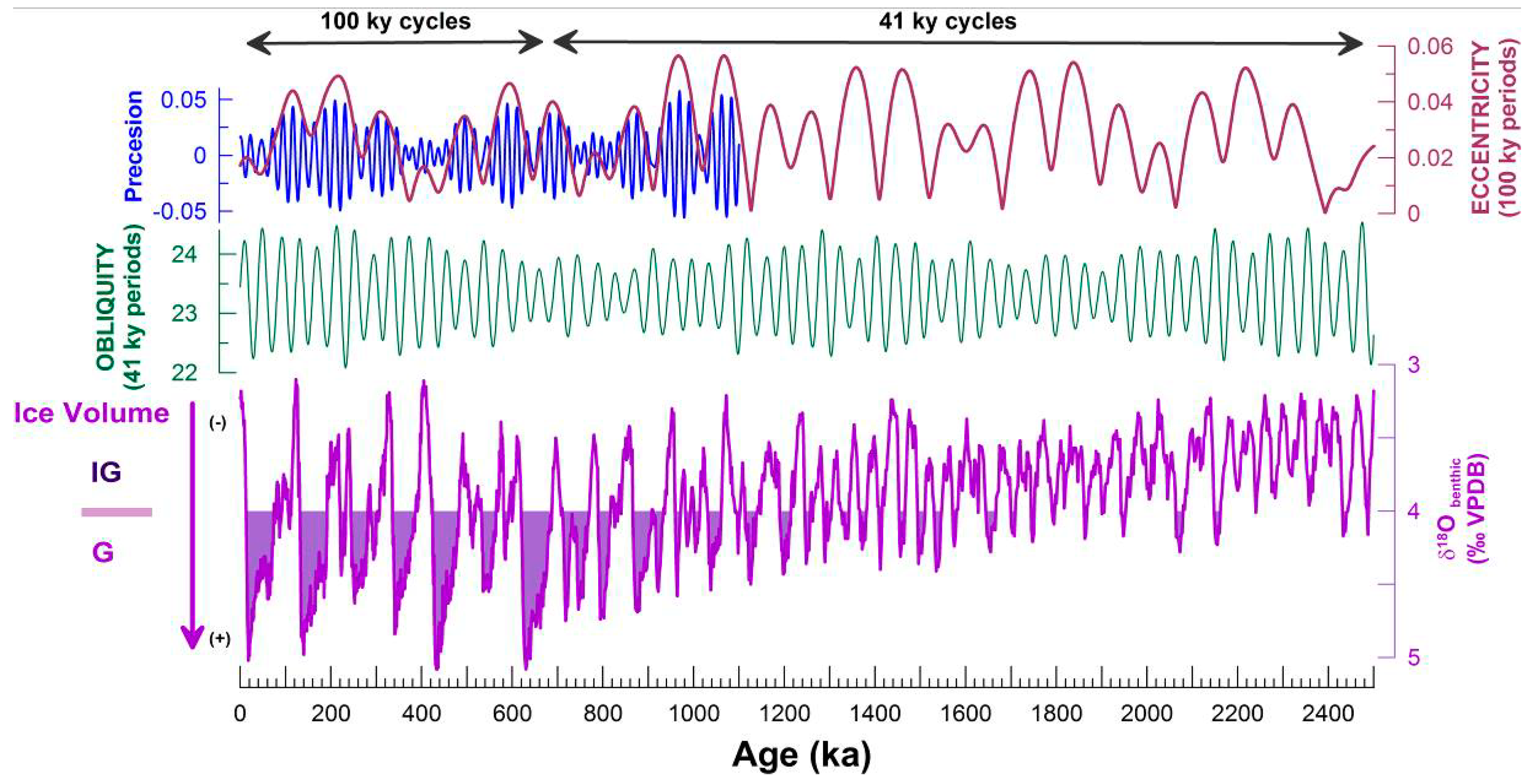
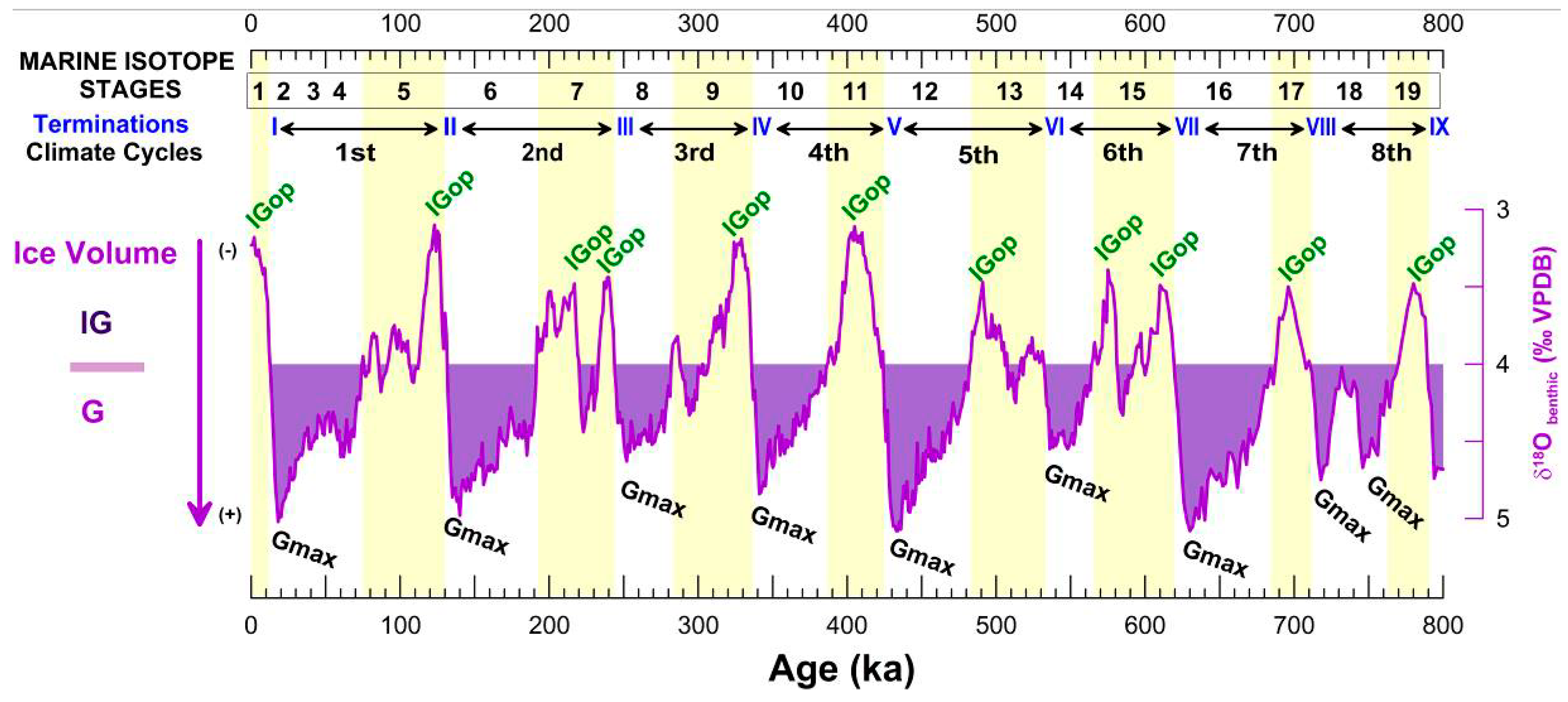
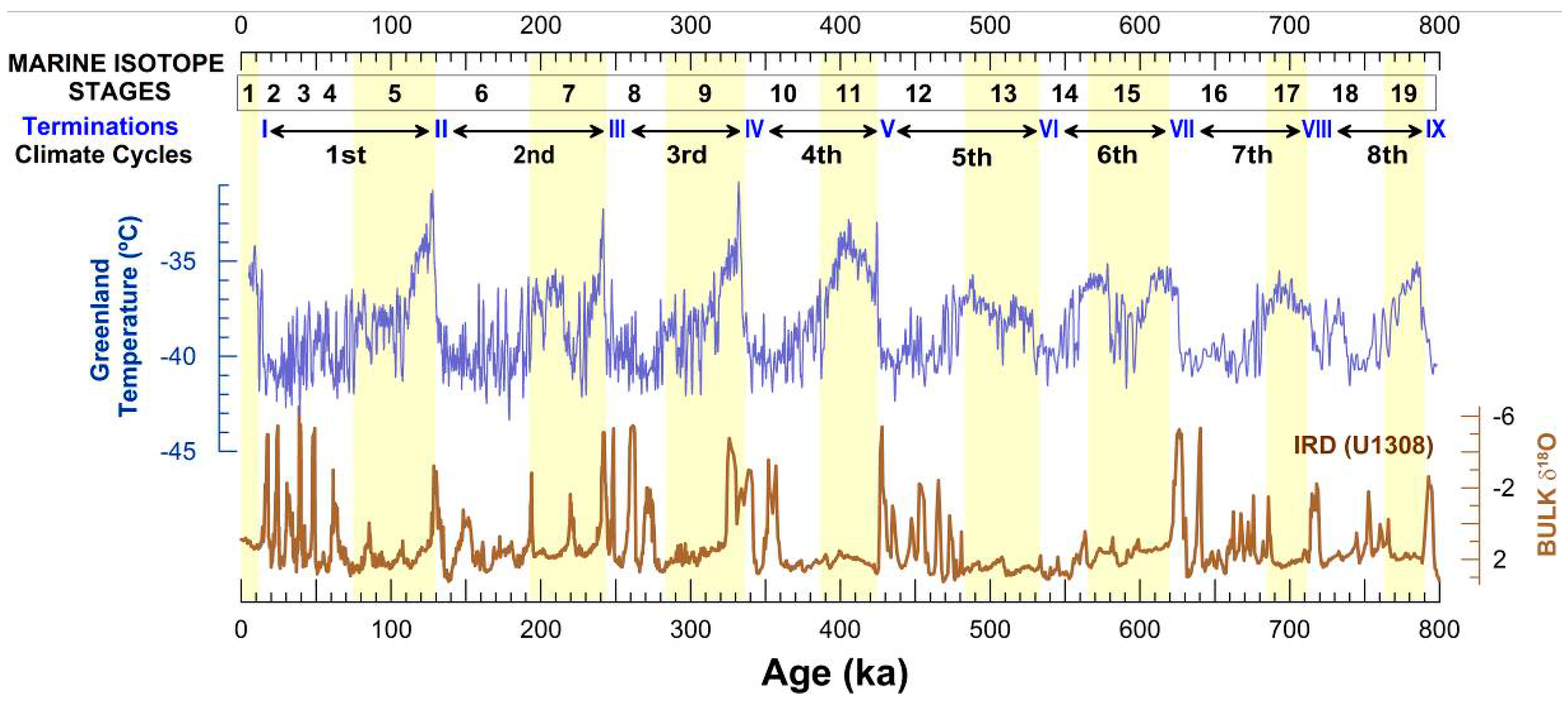
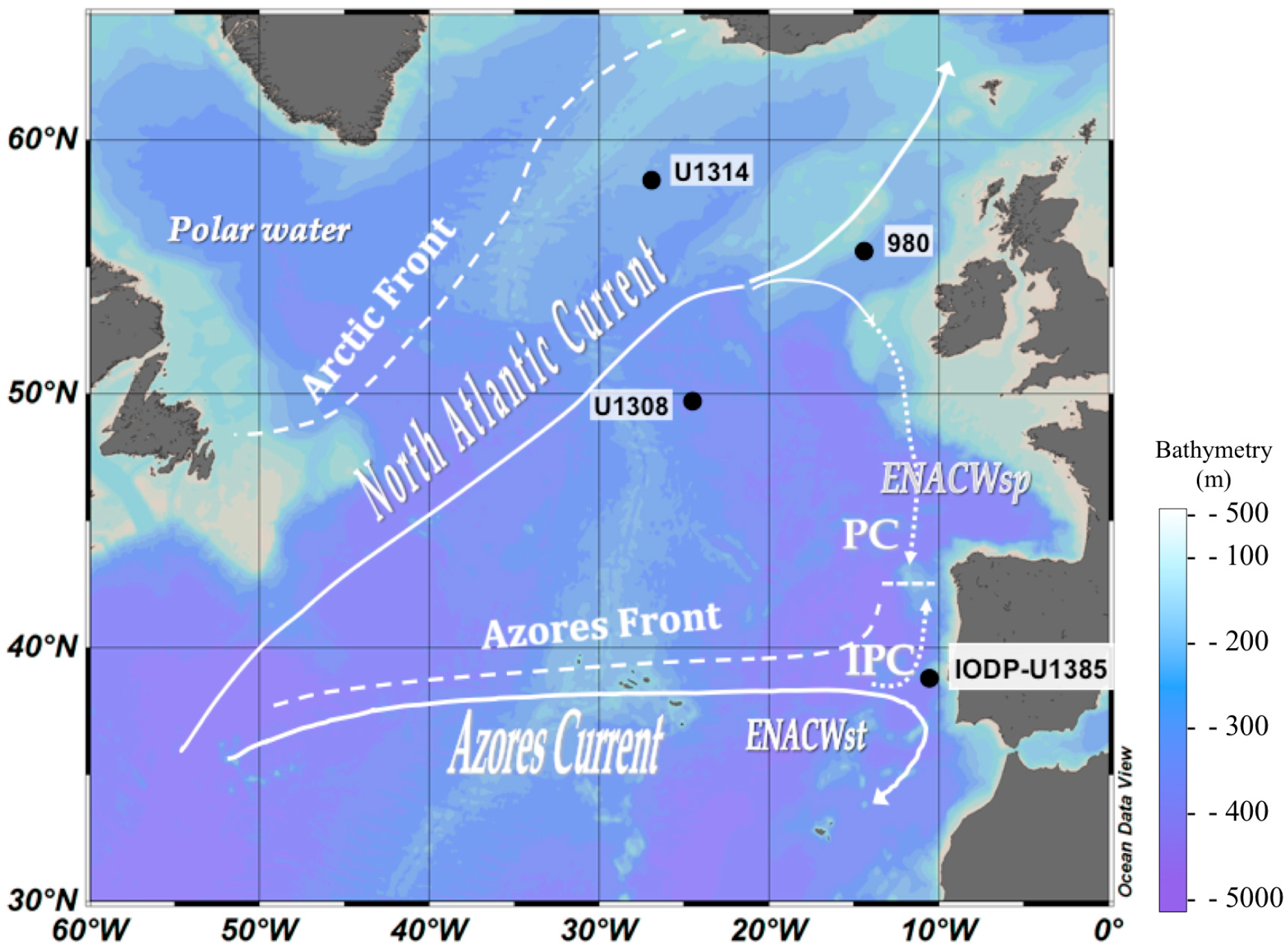
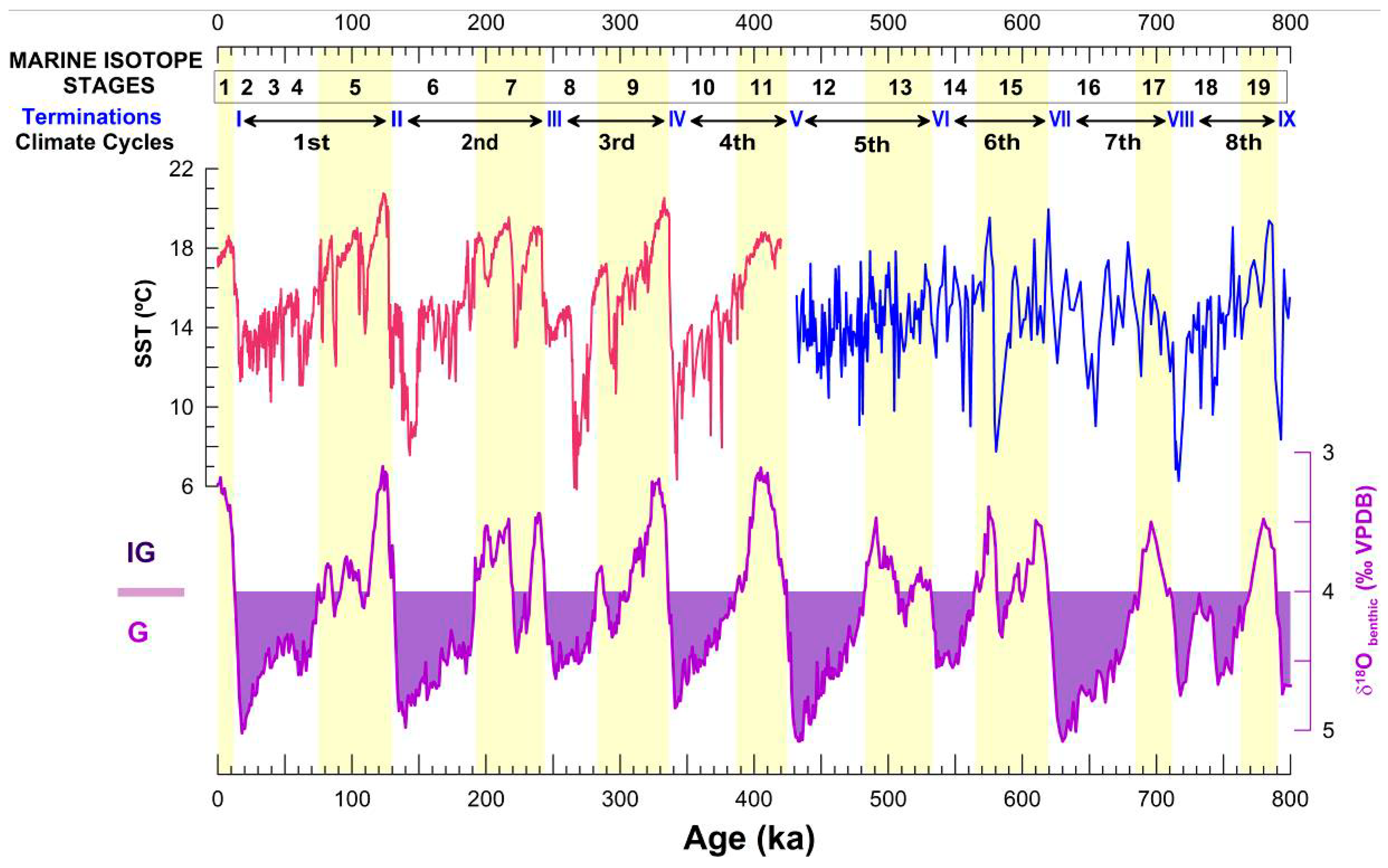
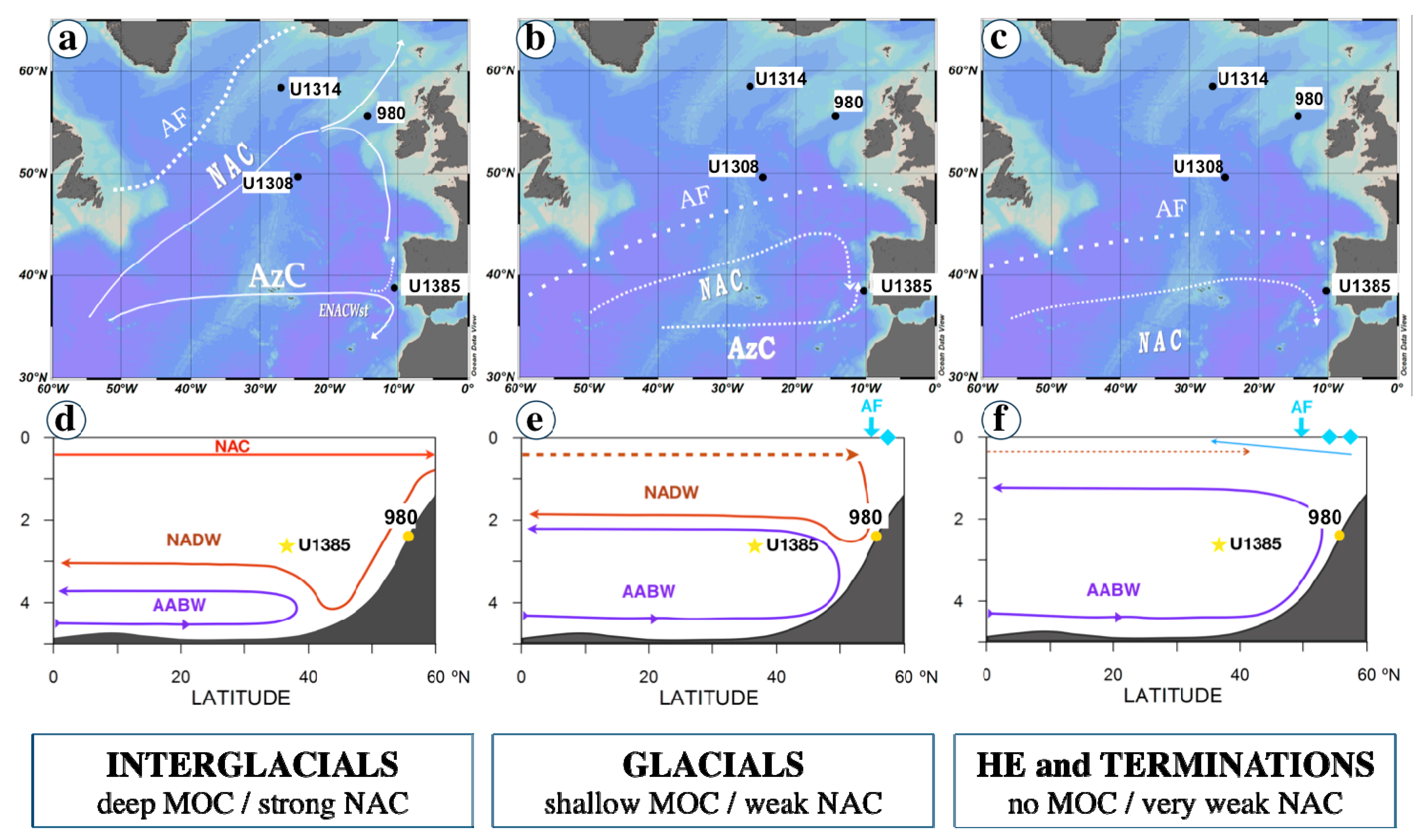
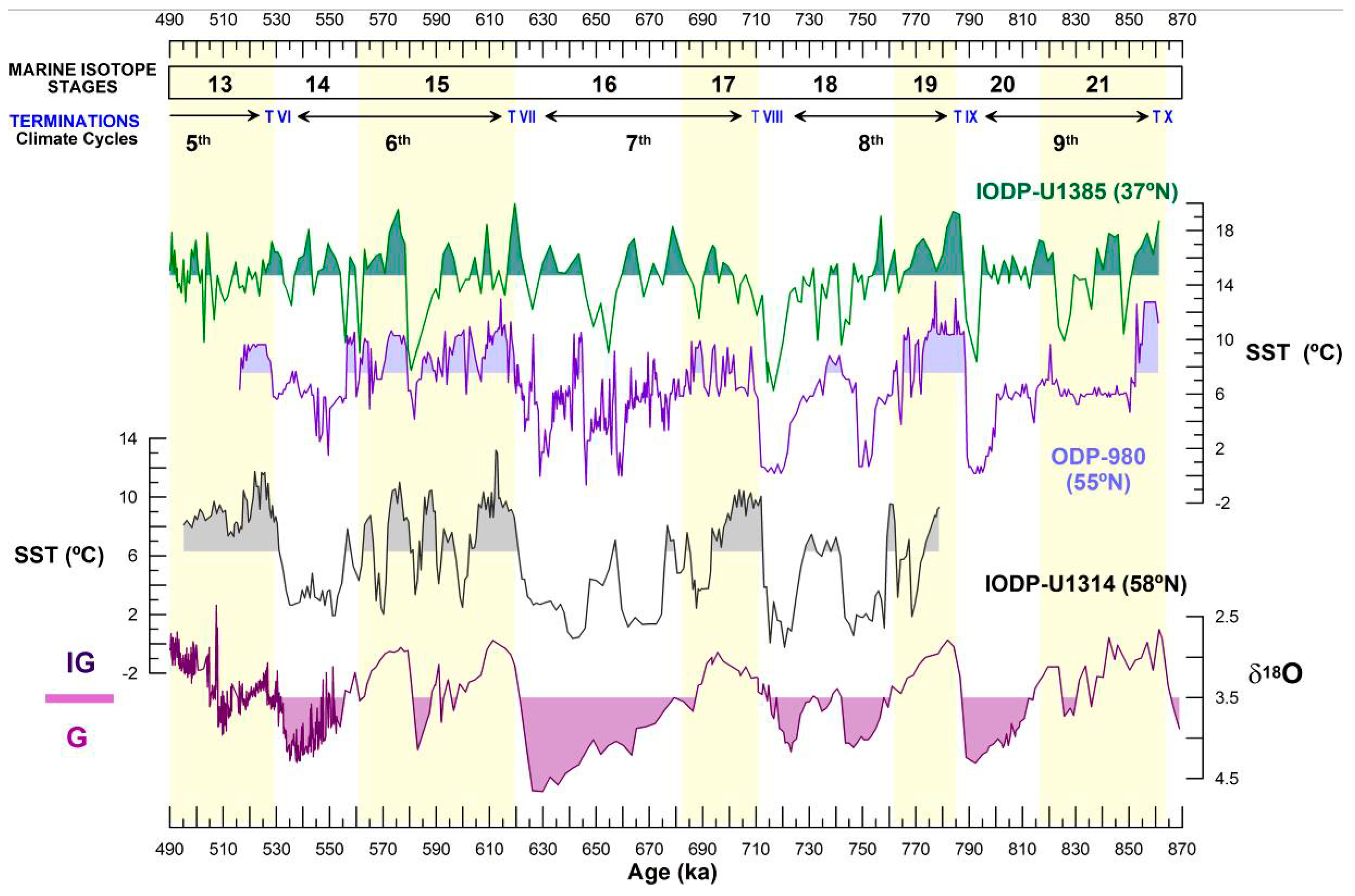
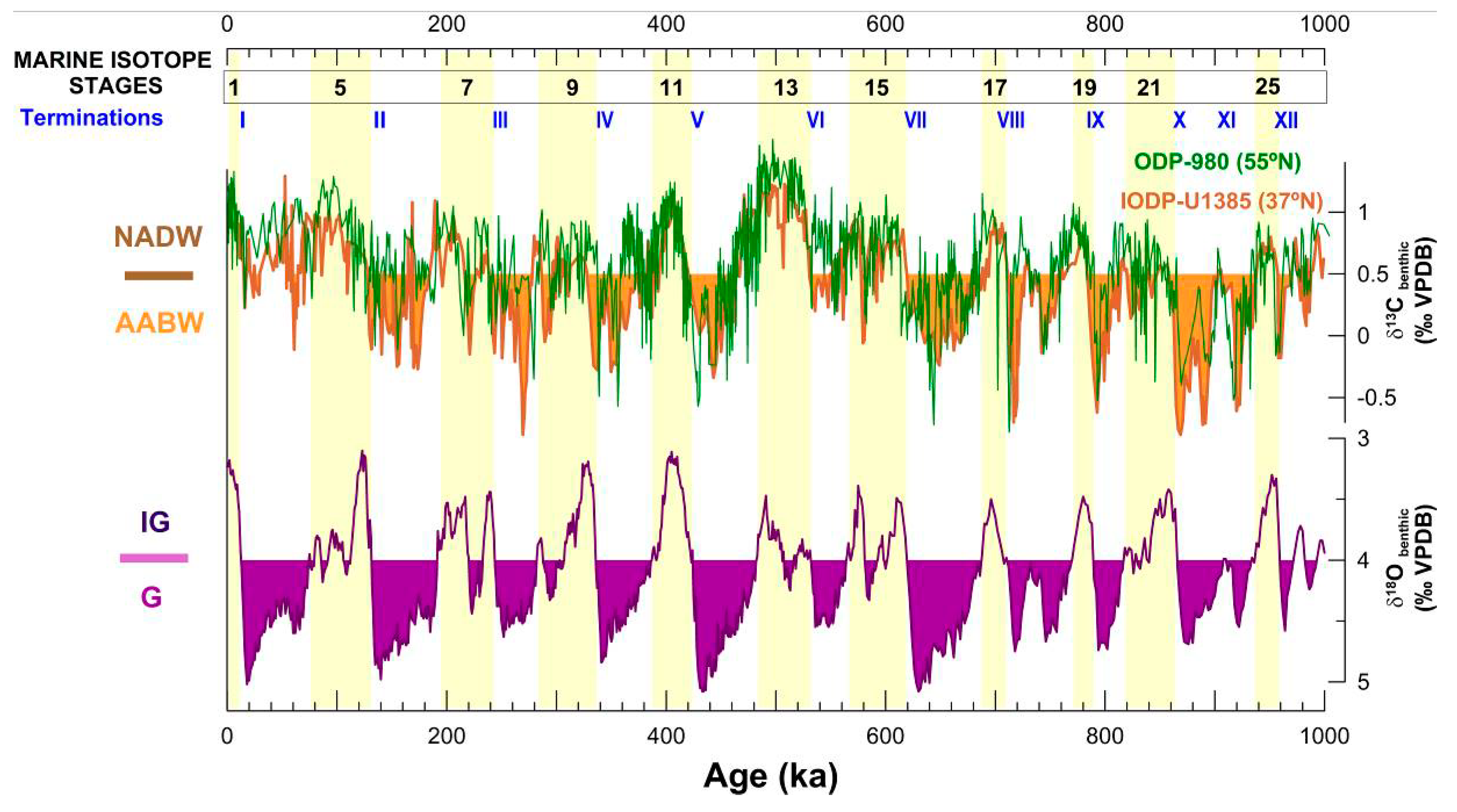
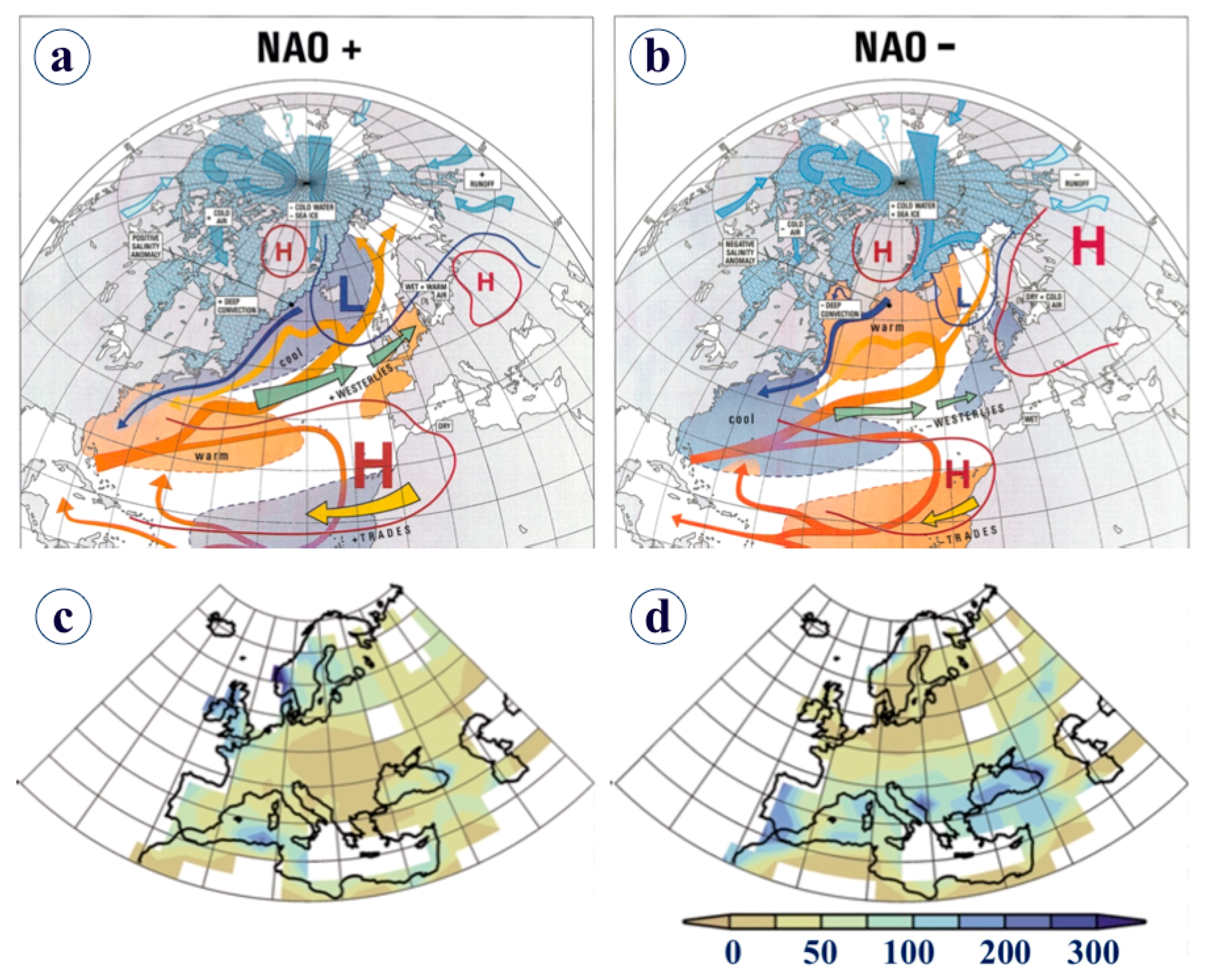
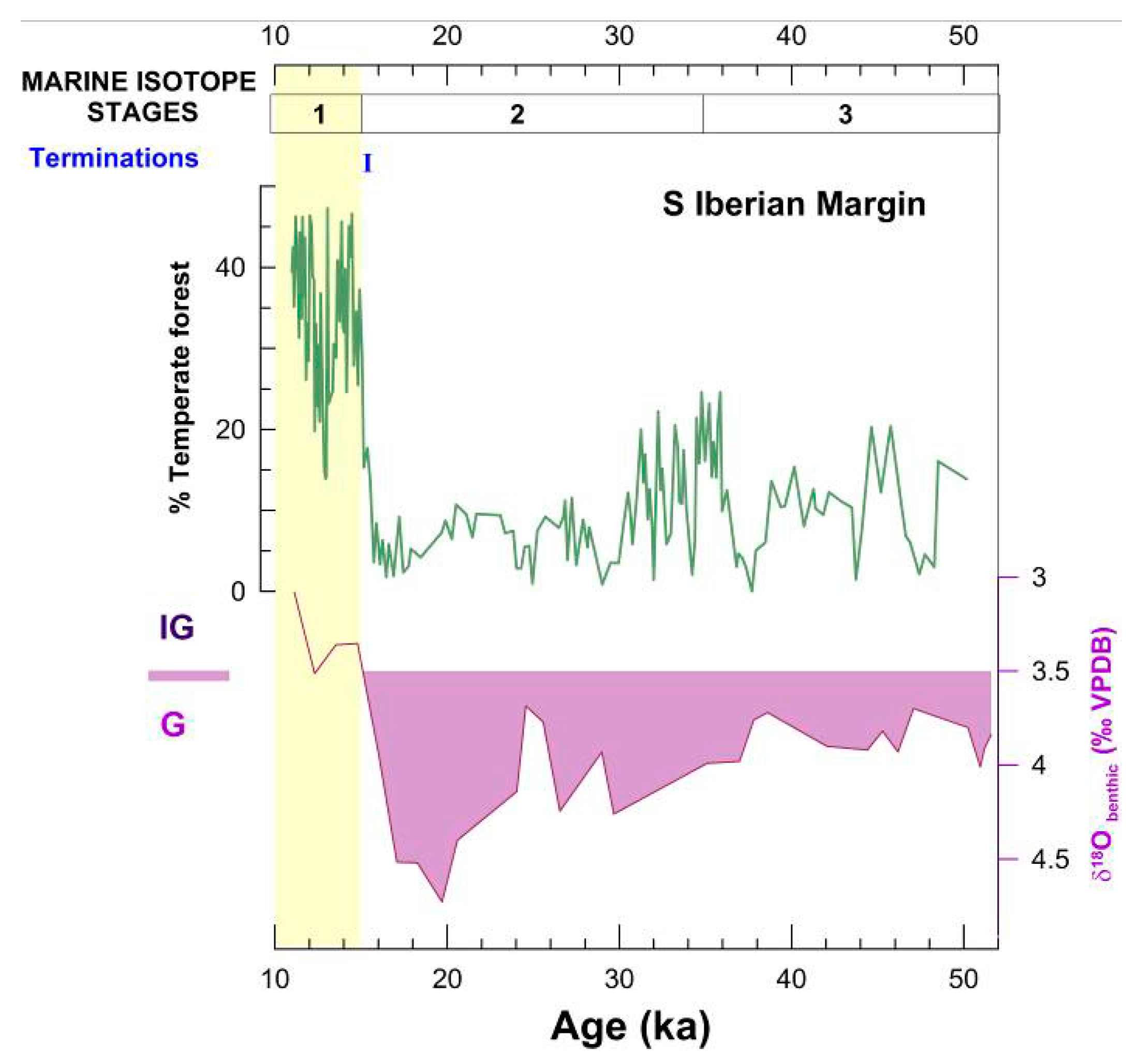
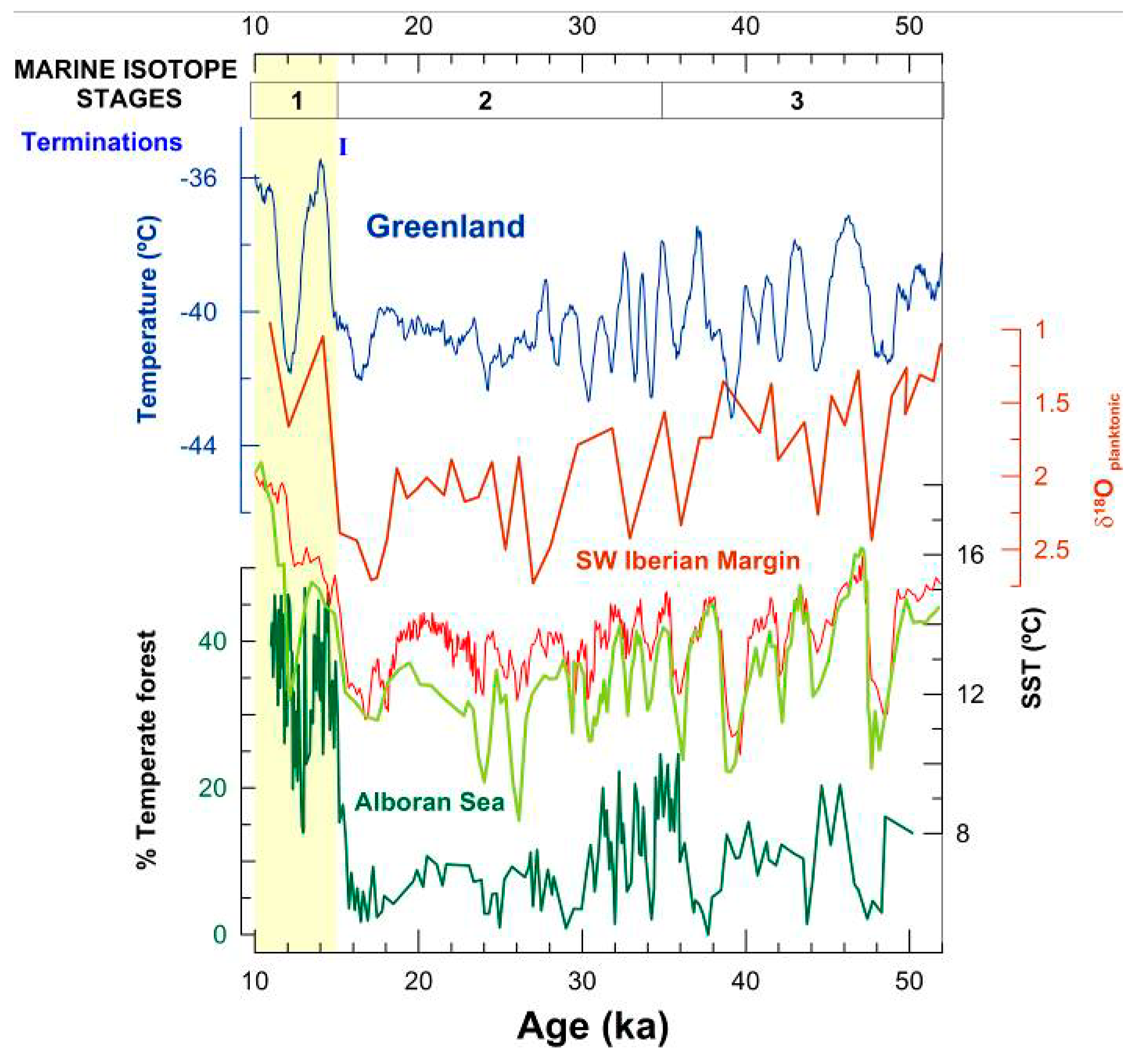
© 2019 by the author. Licensee MDPI, Basel, Switzerland. This article is an open access article distributed under the terms and conditions of the Creative Commons Attribution (CC BY) license (http://creativecommons.org/licenses/by/4.0/).
Share and Cite
Martin-Garcia, G.M. Oceanic Impact on European Climate Changes during the Quaternary. Geosciences 2019, 9, 119. https://doi.org/10.3390/geosciences9030119
Martin-Garcia GM. Oceanic Impact on European Climate Changes during the Quaternary. Geosciences. 2019; 9(3):119. https://doi.org/10.3390/geosciences9030119
Chicago/Turabian StyleMartin-Garcia, Gloria M. 2019. "Oceanic Impact on European Climate Changes during the Quaternary" Geosciences 9, no. 3: 119. https://doi.org/10.3390/geosciences9030119
APA StyleMartin-Garcia, G. M. (2019). Oceanic Impact on European Climate Changes during the Quaternary. Geosciences, 9(3), 119. https://doi.org/10.3390/geosciences9030119




